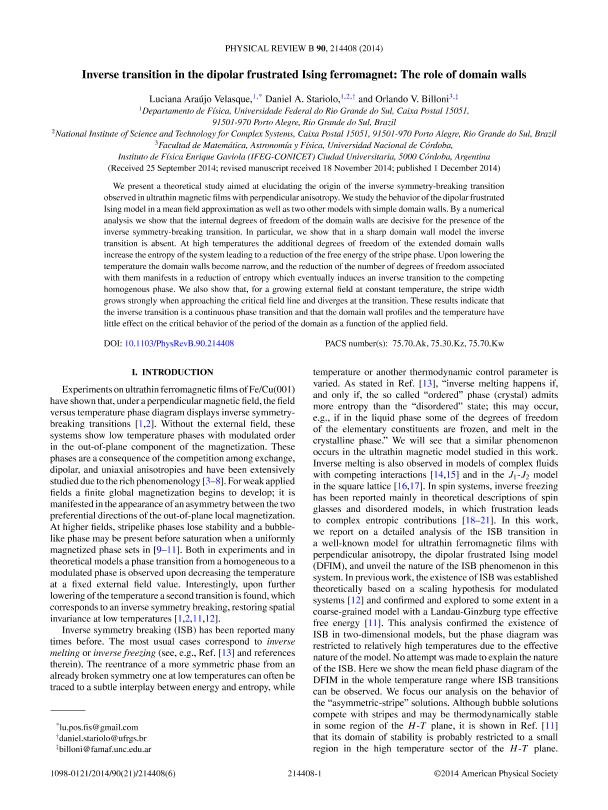Mostrar el registro sencillo del ítem
dc.contributor.author
Araujo Velasque, Luciana
dc.contributor.author
Stariolo, Daniel Adrian
dc.contributor.author
Billoni, Orlando Vito

dc.date.available
2017-12-27T17:47:48Z
dc.date.issued
2014-12
dc.identifier.citation
Billoni, Orlando Vito; Araujo Velasque, Luciana; Stariolo, Daniel Adrian; Inverse transition in the dipolar frustrated Ising ferromagnet: The role of domain walls; American Physical Society; Physical Review B: Condensed Matter and Materials Physics; 90; 21; 12-2014; 2144081-2144086
dc.identifier.issn
1098-0121
dc.identifier.uri
http://hdl.handle.net/11336/31665
dc.description.abstract
We present a theoretical study aimed at elucidating the origin of the inverse symmetry-breaking transitionobserved in ultrathin magnetic films with perpendicular anisotropy. We study the behavior of the dipolar frustratedIsing model in a mean field approximation as well as two other models with simple domain walls. By a numericalanalysis we show that the internal degrees of freedom of the domain walls are decisive for the presence of theinverse symmetry-breaking transition. In particular, we show that in a sharp domain wall model the inversetransition is absent. At high temperatures the additional degrees of freedom of the extended domain wallsincrease the entropy of the system leading to a reduction of the free energy of the stripe phase. Upon lowering thetemperature the domain walls become narrow, and the reduction of the number of degrees of freedom associatedwith them manifests in a reduction of entropy which eventually induces an inverse transition to the competinghomogenous phase. We also show that, for a growing external field at constant temperature, the stripe widthgrows strongly when approaching the critical field line and diverges at the transition. These results indicate thatthe inverse transition is a continuous phase transition and that the domain wall profiles and the temperature havelittle effect on the critical behavior of the period of the domain as a function of the applied field.
dc.format
application/pdf
dc.language.iso
eng
dc.publisher
American Physical Society

dc.rights
info:eu-repo/semantics/openAccess
dc.rights.uri
https://creativecommons.org/licenses/by-nc-sa/2.5/ar/
dc.subject
Inverse Symmetry-Breaking
dc.subject
Ultrathin
dc.subject
Magnetic
dc.subject
Films
dc.subject.classification
Astronomía

dc.subject.classification
Ciencias Físicas

dc.subject.classification
CIENCIAS NATURALES Y EXACTAS

dc.title
Inverse transition in the dipolar frustrated Ising ferromagnet: The role of domain walls
dc.type
info:eu-repo/semantics/article
dc.type
info:ar-repo/semantics/artículo
dc.type
info:eu-repo/semantics/publishedVersion
dc.date.updated
2017-12-26T20:36:27Z
dc.journal.volume
90
dc.journal.number
21
dc.journal.pagination
2144081-2144086
dc.journal.pais
Estados Unidos

dc.journal.ciudad
New York
dc.description.fil
Fil: Araujo Velasque, Luciana. Universidade Federal do Rio Grande do Sul; Brasil
dc.description.fil
Fil: Stariolo, Daniel Adrian. Universidade Federal do Rio Grande do Sul; Brasil
dc.description.fil
Fil: Billoni, Orlando Vito. Consejo Nacional de Investigaciones Científicas y Técnicas. Centro Científico Tecnológico Conicet - Córdoba. Instituto de Física Enrique Gaviola. Universidad Nacional de Córdoba. Instituto de Física Enrique Gaviola; Argentina
dc.journal.title
Physical Review B: Condensed Matter and Materials Physics

dc.relation.alternativeid
info:eu-repo/semantics/altIdentifier/doi/http://dx.doi.org/10.1103/PhysRevB.90.214408
dc.relation.alternativeid
info:eu-repo/semantics/altIdentifier/url/https://journals.aps.org/prb/abstract/10.1103/PhysRevB.90.214408
Archivos asociados
